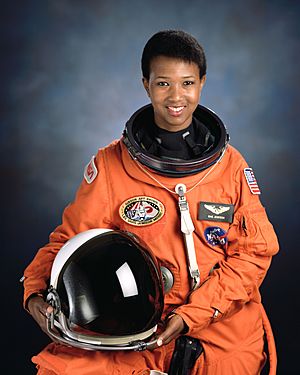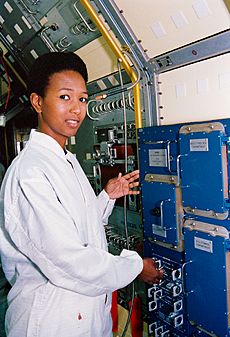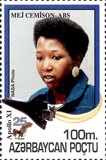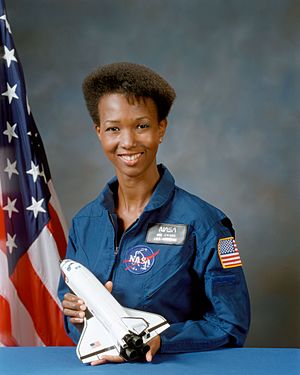Mae Jemison facts for kids
Quick facts for kids
Mae Jemison
|
|
|---|---|

Jemison in July 1992
|
|
| Born |
Mae Carol Jemison
October 17, 1956 Decatur, Alabama, U.S.
|
| Space career | |
| NASA astronaut | |
|
Time in space
|
7d 22h 30m |
| Selection | NASA Group 12 (1987) |
| Missions | STS-47 |
|
Mission insignia
|
|
| Retirement | March 1993 |
Mae Carol Jemison (born October 17, 1956) is an amazing American engineer, doctor, and former NASA astronaut. She made history by becoming the first Black woman to travel into space! She flew as a mission specialist aboard the Space Shuttle Endeavour. Mae Jemison joined NASA's astronaut team in 1987. She was chosen for the STS-47 mission, where she orbited Earth for almost eight days, from September 12 to 20, 1992.
Mae was born in Alabama and grew up in Chicago. She went to Stanford University and earned degrees in chemical engineering and African-American studies. Later, she received her medical degree from Cornell University. Before becoming an astronaut, Jemison worked as a doctor for the Peace Corps in Liberia and Sierra Leone from 1983 to 1985. She was a general practitioner, helping many different kinds of patients. Her dream was to go to space, so she applied to NASA.
After leaving NASA in 1993, Jemison started her own company, The Jemison Group, Inc. This company focuses on how technology can help people and encourages science and social change. In 1994, she also created a non-profit group called The Dorothy Jemison Foundation for Excellence. This foundation works to improve education. Through her foundation, she leads the 100 Year Starship project, which is funded by DARPA. Mae Jemison has also written books for children and appeared on TV, including an episode of Star Trek: The Next Generation in 1993. She has received many special awards and has been honored in the National Women's Hall of Fame and the International Space Hall of Fame.
Contents
Early Life and Education
Mae Carol Jemison was born in Decatur, Alabama, on October 17, 1956. She was the youngest of three children. Her father, Charlie, was a maintenance supervisor, and her mother, Dorothy, was an elementary school teacher in Chicago, Illinois.
Mae loved learning about nature and the human body. She used her observations to understand science better. Her parents always supported her interest in science. However, some of her teachers did not. When she was young, she felt frustrated because there were no female astronauts during the Apollo missions. She once said she was "really irritated that there were no women astronauts."
Jemison started ballet lessons when she was 8 or 9 years old. She entered high school at just 12 years old! There, she joined the cheerleading team and the Modern Dance Club. She learned many dance styles, including African, Japanese, ballet, jazz, and modern dance. When she was 14, she tried out for the main role in the musical West Side Story. She didn't get the main part but was chosen as a background dancer.
After finishing high school in Chicago in 1973, Jemison went to Stanford University at age 16. She was one of very few African-American students in her classes. She also faced discrimination from some of her teachers. In an interview, Jemison said it was hard to go to Stanford so young, but her confidence might have helped her.
At Stanford, Jemison led the Black Students Union. She also helped create a musical and dance show called Out of the Shadows. In her last year of college, she had to choose between going to medical school or becoming a professional dancer. She graduated from Stanford in 1977. She earned a B.S. degree in chemical engineering and a B.A. degree in African and African-American studies. While at Stanford, Mae thought about applying to NASA.
Medical Career
Jemison attended Cornell Medical School. During her training, she traveled to use her medical skills to help people. She went to Cuba for a study and worked at a Cambodian refugee camp in Thailand. She also worked for Flying Doctors in East Africa. While studying at Cornell, Jemison continued to dance. She took classes at the Alvin Ailey American Dance Theater. After getting her M.D. degree in 1981, she completed an internship in 1982. Then, she worked as a general practitioner for a medical group. A general practitioner is a doctor who helps many different patients, rather than focusing on just one area of medicine.
In 1983, Jemison joined the Peace Corps and worked as a medical officer until 1985. She served in Liberia and Sierra Leone. Her job was to manage the Peace Corps' medical staff, pharmacy, and laboratory. She helped patients, wrote self-care guides, and created health and safety rules. She also worked with the Centers for Disease Control on vaccine research.
NASA Career

After returning from the Peace Corps, Jemison applied to NASA's astronaut training program in October 1985. Soon after she applied, NASA had a terrible accident. On January 28, 1986, the Challenger exploded shortly after takeoff in Florida, and all the astronauts died. No more astronauts went into space until scientists understood what happened. A year after this accident, Jemison was one of fifteen people chosen for special training at NASA. This training was physically tough and involved a lot of science studying.
STS-47 Space Mission
On September 28, 1989, Mae Jemison was chosen to join the 50th mission on the Space Shuttle Endeavour, called STS-47. Her role was Mission Specialist 4. She was also the Science Mission Specialist, a new astronaut role focused on scientific experiments.
Jemison’s mission took place from September 12 to 20, 1992. She spent 190 hours, 30 minutes, and 23 seconds in space. She orbited Earth 127 times! The crew worked in two shifts, and Jemison was on the Blue Shift. During the eight-day mission, she would start her shift's communications with a fun quote from Star Trek: "Hailing frequencies open." Jemison took a poster from the Alvin Ailey American Dance Theater with her on the flight. She also brought a West African statue and a photo of Bessie Coleman, who was the first African American woman to get an international pilot license.
STS-47 was a joint mission between the United States and Japan. It included 43 experiments from both countries. Jemison took part in several of these experiments in space. She and Japanese astronaut Mamoru Mohri studied possible ways to treat motion sickness, anxiety, and stress-related problems. Jemison also experimented with making saline solution. She helped with two experiments researching bone cells. Another experiment she joined involved fertilizing female frog eggs to see how tadpoles would grow in zero gravity.
Leaving NASA
Jemison left NASA in March 1993 to start her own company. Homer Hickam, a NASA training manager who had trained Jemison, later said he was sad she left NASA.
Post-NASA Career and Impact
From 1990 to 1992, Jemison was on the board of directors for the World Sickle Cell Foundation. In 1993, she started The Jemison Group Inc. This business looks at how new technology affects people. Jemison also founded the Dorothy Jemison Foundation for Excellence, named after her mother. This foundation supports programs and events like:
- The Earth We Share: a science camp for students aged 12 to 16.
- Shaping the World essay competition.
- Listening to the Future: a program to gather ideas from students.
- Earth Online: a safe online chatroom for students to talk about space and science.
Jemison was a professor of environmental studies at Dartmouth College from 1995 to 2002. There, she led the Jemison Institute for Advancing Technology in Developing Countries. She also became a professor at Cornell University in 1999. Jemison continues to speak about science education and tries to get minority students interested in science. She is a member of several important organizations, including the American Medical Association and the American Chemical Society.
In 1999, Jemison founded BioSentient Corp. She got a license to sell a relaxation technique that she and Mamoru Mohri had tested during their STS-47 mission.
In 2012, her foundation received a large grant to continue its work. The new organization kept the name 100 Year Starship. Jemison is currently the main leader of the 100 Year Starship project. This project aims to make human space travel to another star possible within the next century.
In 2018, she worked with Bayer Crop Science and National 4-H Council on a project called Science Matters. This project encouraged young children to learn about and pursue agricultural sciences.
Mae Jemison Quotes
- "Never be limited by other people's limited imaginations."
- "The best way to make dreams come true is to wake up."
- "Science is very important to me, but I also like to stress that you have to be well-rounded."
- "I want to make sure we use all our talent, not just 25 percent."
Honors and Awards

Mae Jemison has received many awards and honors for her achievements:
- 1988 Essence Science and Technology Award
- 1992 Ebony Black Achievement Award
- 1993 National Women's Hall of Fame
- 1993 People magazine's "50 Most Beautiful People in the World"
- 2002 listed among the 100 Greatest African Americans
- 2004 International Space Hall of Fame
- 2005 The National Audubon Society, Rachel Carson Award
- 2017 Buzz Aldrin Space Pioneer Award
Places Named After Her
Several places have been named in honor of Mae Jemison:
- 1992 Mae C. Jemison Science and Space Museum, Wilbur Wright College, Chicago, Illinois
- 1992 Mae C. Jemison Academy, a public school in Detroit, Michigan
- 2001 Mae Jemison School, an elementary public school in Hazel Crest, Illinois
- 2013 Jemison High School, Huntsville, Alabama
Honorary Doctorates
Mae Jemison has received many honorary doctorates from different colleges, recognizing her contributions:
- 1991 Doctor of Letters, Winston-Salem College, North Carolina
- 1991 Doctor of Science, Lincoln College, Pennsylvania
- 2000 Doctor of Humanities, Princeton University
- 2005 Doctor of Science, Wilson College, North Carolina
- 2006 Doctor of Science, Dartmouth College
- 2007 Doctor of Engineering, Harvey Mudd College
- 2008 Doctor of Humanities, DePaul University
- 2019 Doctor of Humane Letters, Florida Southern College
Filmography
Mae Jemison has appeared in several films and TV shows:
- Star Trek: The Next Generation (1993) – Lieutenant Palmer, episode "Second Chances"
- Susan B. Anthony Slept Here (1995) – herself
- Star Trek: 30 Years and Beyond (1996) – herself
- African American Lives (2006) – herself
- No Gravity (2011) – herself
- The Real (2016) – herself
- Moon Girl and Devil Dinosaur (2023) – Skipster (voice), episode "Skip Ad...olescense"
Images for kids
See also
 In Spanish: Mae Jemison para niños
In Spanish: Mae Jemison para niños






